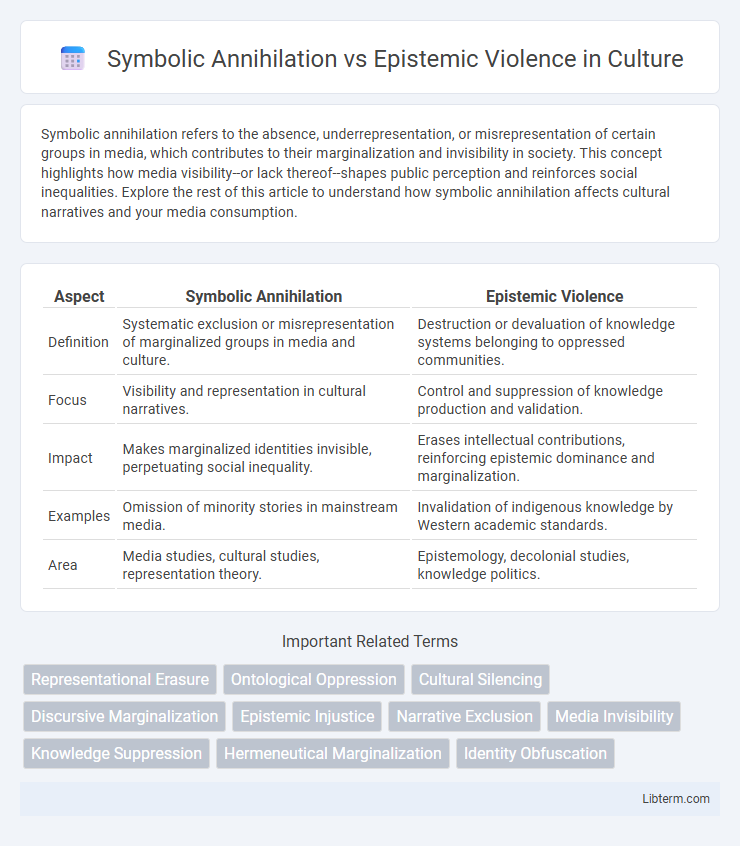Symbolic annihilation refers to the absence, underrepresentation, or misrepresentation of certain groups in media, which contributes to their marginalization and invisibility in society. This concept highlights how media visibility--or lack thereof--shapes public perception and reinforces social inequalities. Explore the rest of this article to understand how symbolic annihilation affects cultural narratives and your media consumption.
Table of Comparison
| Aspect | Symbolic Annihilation | Epistemic Violence |
|---|---|---|
| Definition | Systematic exclusion or misrepresentation of marginalized groups in media and culture. | Destruction or devaluation of knowledge systems belonging to oppressed communities. |
| Focus | Visibility and representation in cultural narratives. | Control and suppression of knowledge production and validation. |
| Impact | Makes marginalized identities invisible, perpetuating social inequality. | Erases intellectual contributions, reinforcing epistemic dominance and marginalization. |
| Examples | Omission of minority stories in mainstream media. | Invalidation of indigenous knowledge by Western academic standards. |
| Area | Media studies, cultural studies, representation theory. | Epistemology, decolonial studies, knowledge politics. |
Introduction to Symbolic Annihilation
Symbolic annihilation refers to the systematic exclusion or misrepresentation of marginalized groups in media, effectively erasing their presence and influence. This concept highlights how absence or stereotyped portrayals contribute to social invisibility and reinforce power imbalances. Recognizing symbolic annihilation is crucial for understanding how media shapes public perception and perpetuates inequality.
Defining Epistemic Violence
Epistemic violence refers to the systematic harm done to marginalized groups by undermining their knowledge systems, experiences, and ways of understanding the world through exclusion, misrepresentation, or erasure. Unlike symbolic annihilation, which involves the absence or misrepresentation of groups in media and culture, epistemic violence targets the very mechanisms of knowledge production and validation, perpetuating power imbalances. This concept is critical in postcolonial studies and feminist theory, highlighting how dominant epistemologies invalidate alternative narratives and sustain inequality.
Historical Contexts of Symbolic Annihilation
Symbolic annihilation refers to the systematic underrepresentation or omission of marginalized groups in media and cultural narratives, reinforcing social inequalities and power structures. Historically, this concept emerged to critique how dominant groups erase or marginalize the histories and identities of minorities, particularly in contexts like racial, gender, and colonial oppression. It contrasts with epistemic violence, which involves the destruction or devaluation of knowledge systems, but both operate within historical frameworks of domination and exclusion.
Mechanisms of Epistemic Violence
Mechanisms of epistemic violence operate through processes such as silencing, marginalization, and misrepresentation, which systematically devalue or erase the knowledge and experiences of oppressed groups. Symbolic annihilation differs by highlighting the absence or trivialization of marginalized identities in media and cultural narratives. Epistemic violence perpetuates inequality by restricting access to epistemic resources and delegitimizing alternative worldviews within dominant knowledge systems.
Intersectionality: Where Symbolic Annihilation Meets Epistemic Violence
Symbolic annihilation occurs when marginalized identities are erased or invisibilized in media and cultural narratives, perpetuating exclusion and reinforcing systemic biases. Epistemic violence refers to the harm caused by the dismissal or devaluation of knowledge systems belonging to oppressed groups, resulting in a loss of agency and distorted representations. Intersectionality reveals how symbolic annihilation and epistemic violence intersect to compound the erasure and misrepresentation of individuals who exist at multiple marginalized identities, amplifying their social invisibility and epistemic disempowerment.
Media Representation and Symbolic Erasure
Symbolic annihilation refers to the media's omission or trivialization of marginalized groups, effectively erasing their presence and identities from cultural narratives. Epistemic violence involves the systematic devaluation and distortion of knowledge produced by these groups, undermining their authority and perspectives in media discourse. Both phenomena contribute to symbolic erasure by perpetuating exclusion and misrepresentation, reinforcing dominant power structures within media representation.
Educational Systems and the Perpetuation of Epistemic Violence
Educational systems often contribute to epistemic violence by symbolically annihilating marginalized knowledge and perspectives, effectively erasing diverse epistemologies from curricula. This systematic exclusion reinforces dominant cultural narratives and perpetuates inequalities by invalidating alternative ways of knowing. The persistent sidelining of non-dominant epistemologies hinders critical consciousness and sustains structural power imbalances within education and broader society.
Social Consequences of Invisibility and Silencing
Symbolic annihilation and epistemic violence both contribute to the social consequences of invisibility and silencing by erasing marginalized groups from cultural narratives and knowledge production. Symbolic annihilation occurs through media representation that omits or trivializes these groups, leading to their social exclusion and diminished identities. Epistemic violence involves the systematic invalidation of marginalized knowledge, reinforcing power imbalances and limiting access to social, political, and economic opportunities.
Strategies for Resistance and Reclamation
Strategies for resistance against symbolic annihilation involve amplifying marginalized voices through media representation, reclaiming cultural narratives, and fostering community-driven storytelling to counter invisibility. In combating epistemic violence, activists prioritize decolonizing knowledge systems by challenging dominant epistemologies, promoting indigenous and local knowledge frameworks, and creating inclusive platforms for diverse epistemic contributions. Both approaches emphasize collective agency and critical media literacy as essential tools for reclaiming identity and knowledge autonomy within hegemonic structures.
Towards Inclusive Knowledge Production
Symbolic annihilation refers to the underrepresentation or misrepresentation of marginalized groups in media and academia, which erases their experiences and voices from dominant narratives. Epistemic violence involves the systematic devaluation and suppression of non-Western or indigenous knowledge systems, perpetuating intellectual exclusion and reinforcing power hierarchies. Towards inclusive knowledge production requires actively integrating diverse epistemologies and ensuring equitable representation to challenge dominant knowledge paradigms and promote social justice.
Symbolic Annihilation Infographic

 libterm.com
libterm.com